Meet the Thrashers: Learn About Thrasher Birds
Updated: Jun. 06, 2022
Get to know the thrasher birds. Learn where to spot these birds, how to identify them, what their songs sound like and how to tell them apart.
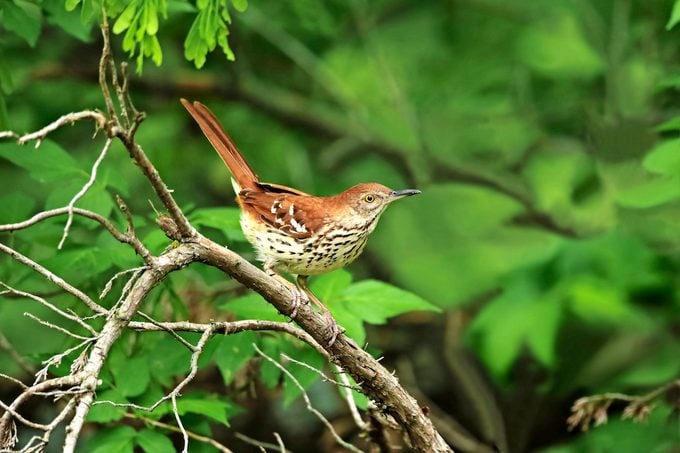
Investigate the sound of rustling leaves on the ground under a dense thicket, especially in the southeastern states, and you may discover a long-tailed bird a little larger than a robin, with a bright reddish brown back. Watch for its signature behavior of using its strong bill to flip dead leaves and debris from side to side—and not in a gentle way. If you see it thrashing the ground cover, you’ve just witnessed how the brown thrasher got its name.
Backyard Thrasher Birds
Brown Thrasher
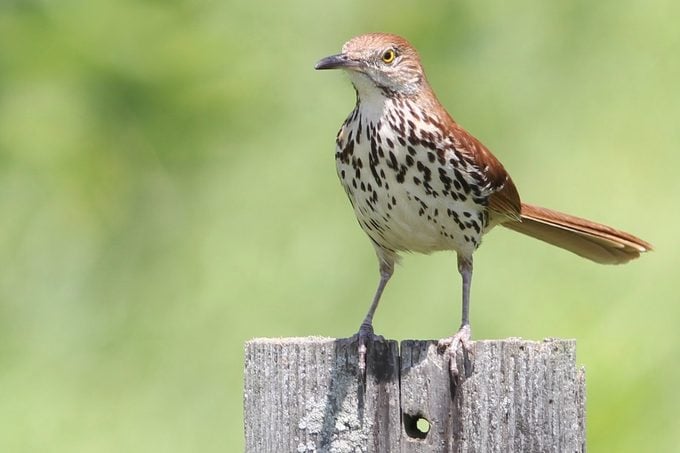
Almost everywhere east of the Rocky Mountains in the lower 48 states and southern Canada, the brown thrasher lurks in forest edges and overgrown fields. It readily comes to backyards that have plenty of bushes and dense, low cover. Much of the time it stays out of sight, but it does emerge to forage on lawns and around gardens.
Brown thrashers usually stay low, feasting on ground-dwelling insects or on berries in thickets. Members of a pair work together to build a bulky nest of sticks and weeds, hidden in shrubs or vines within a few feet of the ground. But when the male is ready to sing, he perches at the top of a tall tree to belt out a song of short, rich phrases. Each phrase is doubled: chuvee chuvee, pikiyew pikiyew, chook chook, tuchoowee tuchoowee—on and on, with endless variations. That’s when it may click for you that the brown thrasher belongs to the same family as the northern mockingbird and gray catbird—it certainly shares their gifts for singing.
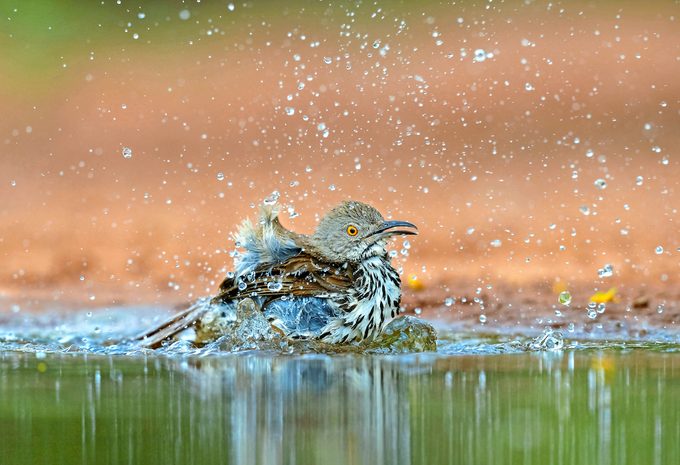
Long-billed thrasher
Long-billed thrasher
A bird in South Texas that looks almost exactly like a brown thrasher but with a slightly longer bill and brighter orange eyes is a relative called the long-billed thrasher. Elsewhere in the Southwest and West, six other species of thrashers take their places in different habitats.
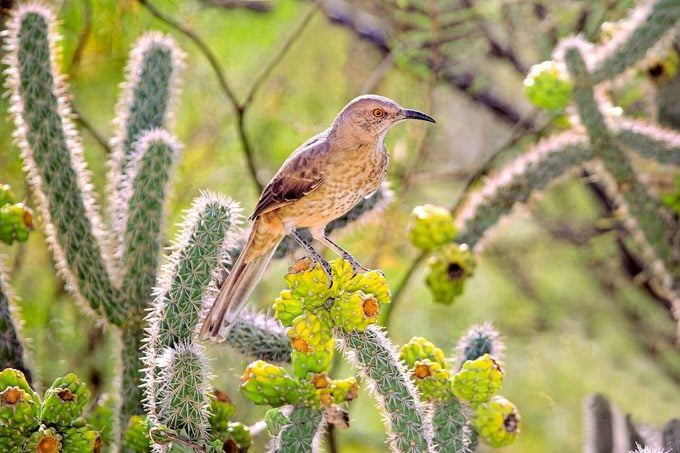
Thrashers of Cactus Country
Curve-billed thrasher
In lowlands of the Southwest, from Arizona to Texas, one of the most familiar bird voices sings a loud whit-wheet!—the call of the curve-billed thrasher. A pale gray-brown bird without strong markings, it’s best known by its stout, curved black bill and its staring orange eyes. Living among the sparse plant life of the desert, where it wouldn’t be easy to hide, the curve-billed doesn’t even try: It dashes about in the open and often perches on top of a cactus to sing its short, abrupt, jumbled phrases. It readily adapts to living in suburbs and gardens, especially those that have some cholla cactus—its favorite nesting site.
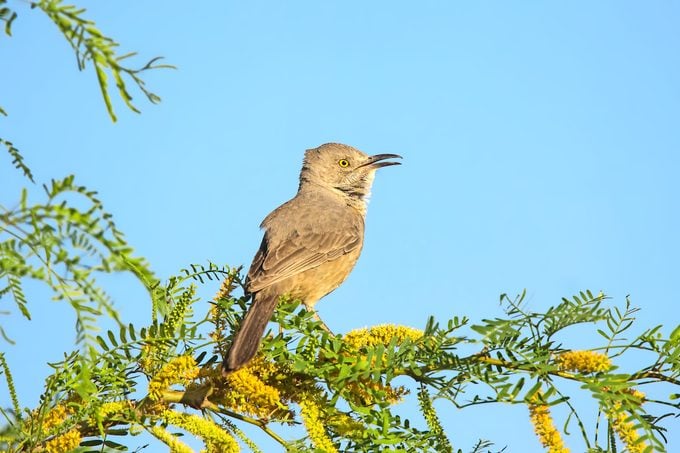
Bendire’s thrasher
An uncommon desert denizen that’s easy to miss is Bendire’s thrasher. Looking very much like the curve-billed, it lives mainly in Arizona and parts of western New Mexico. Bendire’s has a slightly shorter, straighter bill than the curve-billed thrasher. But it’s most readily recognized by its song—a much more melodious and continuous warbling than the choppy sound of its more common relative.
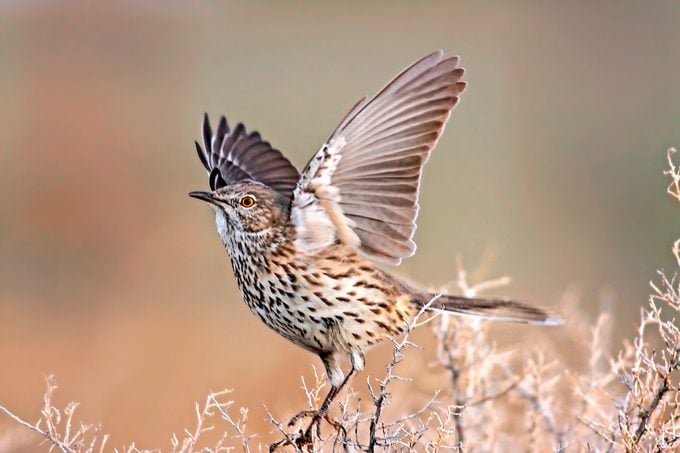
Sage thrasher
A bird with an even shorter bill and a sweeter song is the sage thrasher. During the summer, this smallest thrasher lives in wide-open sagebrush deserts in the interior of the West. In winter it migrates south to southwestern deserts and foothills, sometimes congregating in open juniper woods. Rarely, a migrating sage thrasher gets lost and shows up in the eastern states.
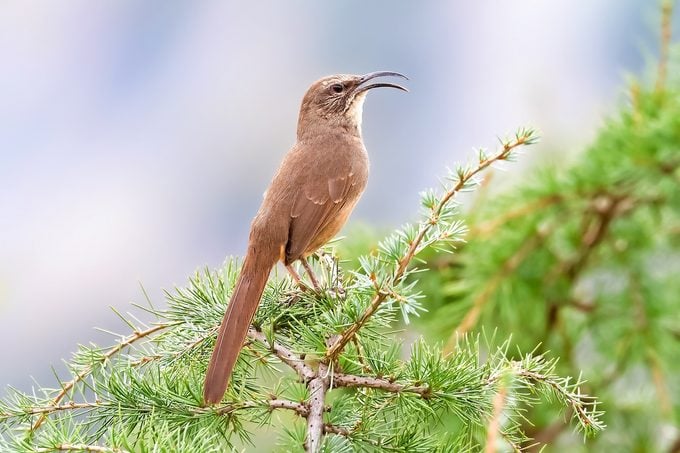
Sickle-Billed Skulkers
California thrasher
Although one southwestern bird is officially named the curve-billed thrasher, three other species actually have more strongly curved bills. One of those, the California thrasher, is a specialty of its namesake state. It lives only west of the Sierras in California and part of northern Baja. Although it favors thickets in wild country, it also lives in parks and gardens that have enough dense, low cover. Its overall dark color and deeply curved bill make it recognizable. The California thrasher is easiest to see when it perches atop a bush to sing short, repeated phrases, which often include imitations of other birds, reflecting its place in the mockingbird family.
Crissal Thrasher
Similar to the California thrasher but living farther east, the crissal thrasher is found from southeastern California to western Texas. Like other thrashers, it has a loud song. But it’s usually detected by its callnote, a rolling chorry-chorry. Hiding in the thickest cover along desert rivers and in oak woodland of the foothills, it usually stays out of sight. Aside from the curve of its bill, the crissal thrasher is best known by the bright reddish brown under its tail, a patch of feathers sometimes called the crissum—hence the bird’s name.
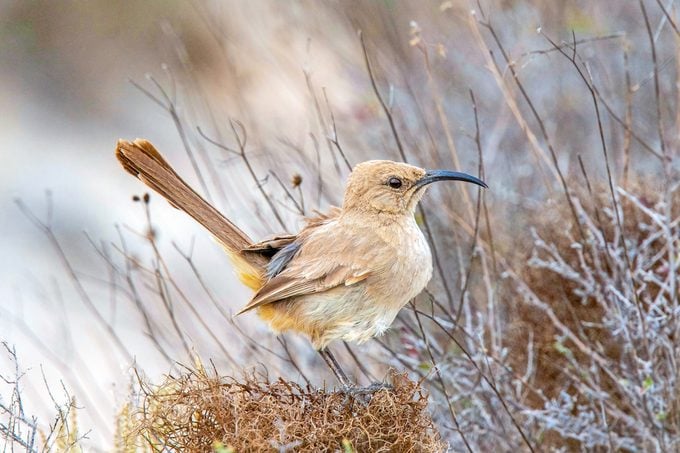
LaConte’s thrasher
The final member of the group is the least-known: the pale sand-colored LeConte’s thrasher. It runs on the ground, with its tail held up in the air, in the most barren deserts of southeastern California, southern Nevada and western Arizona. Even the most dedicated birders rarely see it without making a special trip.
Wherever they live, thrashers add rich and varied songs to their surroundings. They can be fascinating to watch, even if they’re hard to see. So it’s worth making the effort to get to know them.
Next, learn all about sparrows: what birders should know.




















